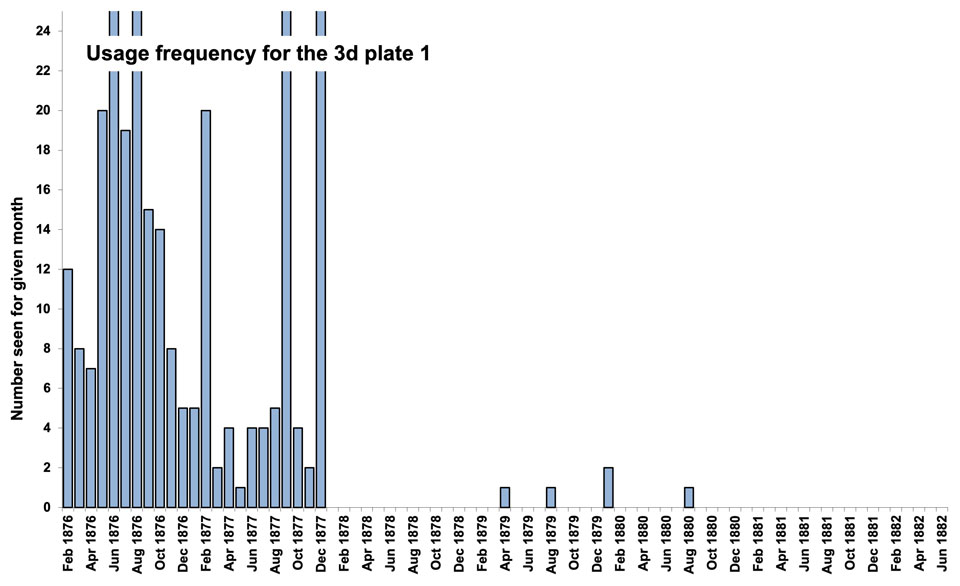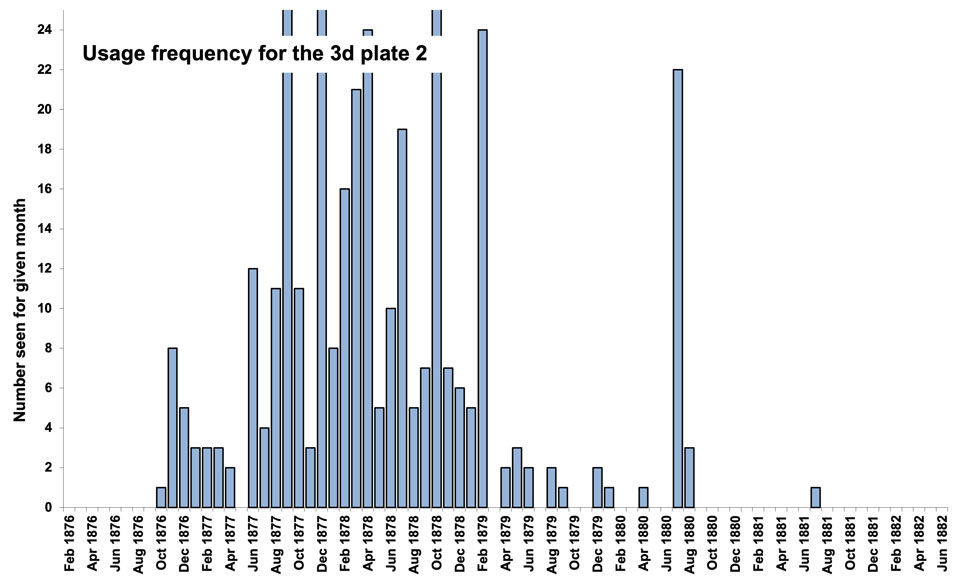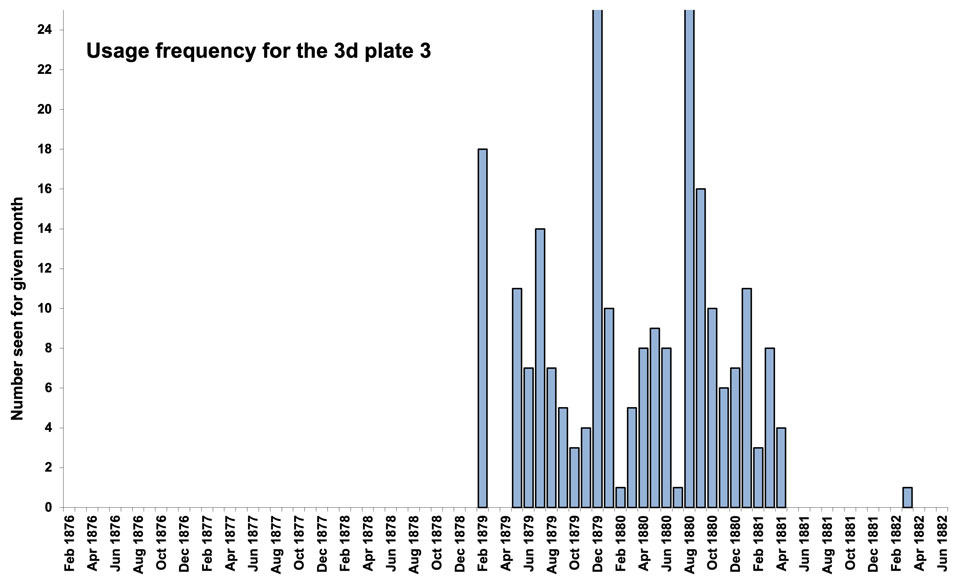1 Essays
2 Die Proofs
3 Sheet Layout
4 Plate Proofs
5 Paper
6 Imprimaturs
7 Colour Standards
8 Specimens
9 Issued Stamps

Date: 1 Feb 1876
Plates: 1-5
Printer: De La Rue
Watermark: Spray (sideways)
Perforation: 14
The 3d Telegraphs was issued on 1 Feb 1876 together with 1d, 1s, and 5s values. However, no example of any telegraph stamp has been found dated earlier than 4 Feb 1876.
It had been decided that telegraph stamps of the same value as postage stamps would be printed in the same colour and on the same paper as the corresponding postage stamps, hence this stamp was printed in carmine on Spray of Rose paper.
Five plates were prepared and registered, imprimaturs exist from all five on Spray paper. Plate 3 was converted to Crown paper part way through its print run. Plates 3 to 5 were re-registered on Crown. Only the registration sheets were printed from plates 4 and 5 on Spray.
Essays



Three essays for the 3d value were prepared by De La Rue for the first issue: Series A and Series B essays dated “24 MAR 75”, and the approved design submitted on 31 Mar 1875.
| A | 3d | 55 | AB | purple-rose |
| B | 3d | 55 | AB | purple-brown |
| C | 3d | 55 | AB | crimson-lake, approved design |
For more details on first issue essays click here.

This is from a set of 12 black & white essays which are undated but believed to be circa 1880. Their purpose is not known, but they are likely not related to the issued stamps.
| — | 3d | — | — | black & white |
For more details on additional essays click here.
Die Proofs
Die proofs are printed in black on white glazed card, typically 92 x 60mm, unless otherwise noted. They are listed below ordered by date, with undated proofs following those with the same plate number. The rightmost column gives the number recorded in our database: in private hands + institutionalised.

To see more 3d Die Proofs click here.
| 1 | June 22, 1875 | — | — | — | 1 |
| 2 | July 2, 1875 | — | — | — | 1 |
| 3 | July 6, 1875 | — | — | — | 1 |
| 4 | July (1)8, 1875† | — | — | “BEFORE HARDENING” | 1 |
| 5 | July 8, 1875 | — | — | “BEFORE HARDENING” | 3 |
| 6 | July 14, 1875 | — | — | “BEFORE HARDENING” | 6 + 2 |
| 7 | no date | — | — | Basic Die Proof | 1 + 1 |
| 8 | July 14, 1875 | 1 | AB | “AFTER HARDENING” | 1 + 1 |
| 9 | July 16, 1875 | 1 | SB | — | 1 |
| 10 | Aug 16, 1875 | 2 | — | “BEFORE STRIKING”, “JPS” | 1 |
| 11 | Aug 16, 1875 | 2 | BB | “AFTER STRIKING”, “JPS” | 2 |
| 12 | Aug 20, 1875 | 2 | — | “AFTER STRIKING” | 1 |
| 13 | Feb 22, 1876 | 3 | — | “BEFORE STRIKING”, “SEJ” | 1 |
| 14 | Feb 24, 1876 | 3 | DE | “After Striking 20 Leads” (“TR”)* | 1* |
| 15 | Nov 23, 1877 | 5 | — | “SNE” | 2 |
* Recorded with and without initials, likely the same one.
† In error for July 8.
Institutionalised/Total: 4/28.
From the Striking Books






| July 20, 1875 | — | — | “240 Leads 1875 …” | 0 + 1* |
| July 20, 1875 | 1† | — | “July 20 / 240 Leads”, “Aug 6 75 / P” | 1 |
| “ | “ | “ | above cut down, AUG 1875 added | “ |
| Feb 28, 1876 | 3 | — | “Feb 28 / 240 Leads”, “21 76” | 0 + 1* |
| July 3, 1877 | 4 | — | July 3 / 240 Leads”, “Aug 1 77” | 1 |
| Nov 29, 1877 | 5 | — | “Nov 29 / 240 Leads”, “Jan 12 78” | 1 |
* Langmead Collection — reconstruction.
† Plate number “1” in manuscript.
In a Countersunk Frame


| no date | — | — | Cut down, set in a countersunk frame | 2 |
Sheet Layout
The sheet had 240 stamps in 12 panes, arranged as three rows of four. Each pane had 20 stamps in four rows of five. To the left of each pane reading upwards was “TELEGRAPHS THREE PENCE.”. Plate numbers were in the upper left and lower right corners, current numbers in the lower left and upper right corners, all reading upwards. At the middle of each side was a cross used as a perforating guide.
A Post Office sheet was two horizontal panes, valued at 10 shillings.

Computer generated image, click to enlarge.
Plate Proofs



Plate proofs are known for plates 2, 3, and 4. Plate 2 TL is a reconstruction as it is in the Langmead Collection in the British Library. It is from a corner of the sheet and is the only one known. Probably unique with no examples available to collectors.
Plate 3 is the most common of the 3d plate proofs. The reconstruction shows there was a block of 12 from the top right corner of the sheet. RA-TA is a strip of three; SD is illustrated in Wright and Creeke. Plate 4 was likely a block of six, but only five are known. OJ-OL is a strip of three.
Red represents an institutionalised example.
Green a known example in private hands.
Blue is unknown but predicted by the pattern.

| Institutionalised/Total: | 1/1 |
| Royal Philatelic Collection: | — |
| British Postal Museum: | — |
| Tapling Collection: | — |
| Langmead Collection: | TL |
| Phillips Collection: | — |

| Institutionalised/Total: | 5/12 |
| Royal Philatelic Collection: | RA-TA |
| British Postal Museum: | — |
| Tapling Collection: | — |
| Langmead Collection: | TB |
| Phillips Collection: | TC |

| Institutionalised/Total: | 3/6 |
| Royal Philatelic Collection: | OJ-OL |
| British Postal Museum: | — |
| Tapling Collection: | — |
| Langmead Collection: | — |
| Phillips Collection: | — |
Paper
The 3d telegraph stamp was printed on the same paper as the corresponding postage stamp. It was printed on Spray of Rose paper.

The watermark as seen from the front of the stamp.
For more details on Spray paper click here.
Imprimaturs



Plates 1 to 3 were registered on 5 Aug 1875, 10 Sept 1875, and 21 Mar 1876.


Plates 4 and 5 were registered on 30 July 1877 and 12 Jan 1878.
The registration sheets for the Telegraphs have been lost. However, we can reconstruct them from known examples and a clear pattern emerges. Most have a column of 12 taken, plus four from the adjacent column, and a plate number example from the opposite corner. One sheet of each value has an extra column of 12 taken.
Plate 1 is an exception, with only six examples removed. This sheet was missed when the first 12 stamps were taken in 1883, and AL and BI seem to have been taken without warrants.
Red represents an institutionalised example.
Green a known example in private hands.

| Institutionalised/Total: | 4/6 |
| Royal Philatelic Collection: | AL, TL |
| British Postal Museum: | AI |
| Tapling Collection: | — |
| Langmead Collection: | — |
| Phillips Collection: | BI |

| Institutionalised/Total: | 8/17 |
| Royal Philatelic Collection: | AA, TL |
| British Postal Museum: | BA, BK |
| Tapling Collection: | AD |
| Langmead Collection: | AL |
| Phillips Collection: | AH, AK |

| Institutionalised/Total: | 8/17 |
| Royal Philatelic Collection: | AA, TL |
| British Postal Museum: | BI, BK |
| Tapling Collection: | AI |
| Langmead Collection: | AL |
| Phillips Collection: | AG, AJ |

| Institutionalised/Total: | 8/17 |
| Royal Philatelic Collection: | AA, TL |
| British Postal Museum: | BI, BK |
| Tapling Collection: | AI |
| Langmead Collection: | AL |
| Phillips Collection: | AC, AE |

| Institutionalised/Total: | 9/17 |
| Royal Philatelic Collection: | AA, TL |
| British Postal Museum: | BI, BK |
| Tapling Collection: | AE |
| Langmead Collection: | AL |
| Phillips Collection: | AC, AF, AH |
Colour Standards

One complete sheet came on to the market in the 1930s: plate 1, imperforate, overprinted Specimen Type 10 horizontally. This late arrival to the market means: the stamps are very fresh (some of the best Victorian stamps in existence); they are not well represented in institutionalised collections that were largely formed at earlier dates; the stamps are mostly in blocks and scarce as singles.
Red represents an institutionalised example.
Green a known example in private hands.

Pane KI-OL is in the Langmead Collection.
Click the images to enlarge.
Specimens



Plate 1 Type 8: possibly unique, no gum, maybe from an official document.
Plate 1 Type 9: scarce, from 3 PO sheets (AI-JL x3), strips of 3 (x2), blocks of 4 (x2) and 10 known.
Plate 1 Type 10: rare, from 1 PO sheet (AE-JH), all singles.



Plate 2 Type 9: scarce, from 4 PO sheets (AA-JD, AE-JH x2, AI-JL), all singles.
Plate 2 Type 9c: scarce, from 2 PO sheets (KE-TH x2), one block of 4 known.
Plate 3 Type 9b: common, from 8 PO sheets (KE-TH x8), strips of 3, 4 (x2), blocks of 4 (x4), 8, 9, 12, 20 (x4), 34, and two complete PO sheets of 40 known.
Click the images to enlarge.
Reference to scarcity, blocks and the number of sheets or panes so treated is derived from reconstructions of known examples within our database.
Issued Stamps
Stamps were issued from plates 1, 2, and 3. Plates 4 and 5 were registered but not put to press on Spray paper.
The usage frequency graphs show that plate 1 was depleted in the stores by Dec 1877, with plate 2 usage overlapping plate 1 but mostly later, and plate 3 following plate 2.
Click the graphs to enlarge.

For postal, fiscal, and railway usage click here.
Issued Stamps — Plate 1
Plate 1 (current no. 479) was registered on 5 Aug 1875 and approved on 9 Aug 1875. It was put to press on 5 Aug 1875 and taken from press on 21 Mar 1876 after printing 35,000 sheets.
Scarcity #5 in mint telegraphs, #14 in used telegraphs.


Mint multiples are scarce with only three pairs and one strip of three known to us.
Used multiples beyond pairs and strips are scarce. Four blocks of four and two blocks of six are known to us. The earliest known used example is 4 Feb 1876 at Leith (illustrated). The official issue date was 1 Feb 1876; however, no example of any Telegraph has been found dated earlier than 4 Feb 1876.


Inverted watermarks are rare. Five mint and four used singles are in our database.
Click the images to enlarge.
Issued Stamps — Plate 2
Plate 2 (current no. 487) was registered on 10 Sept 1875 and approved on 23 Sept 1875. It was put to press on 23 Feb 1876 and taken from press on 30 Apr 1878 after printing 35,000 sheets.
Scarcity #9 in mint telegraphs, #9 in used telegraphs.


Mint multiples are more common than for plate 1 but are still scarce. Two blocks of six, two blocks of four, and several pairs are in our database.
Used multiples are common with blocks of 4, 6, 9, 12 and a complete pane of 20 known to us. The earliest known used example is 31 Oct 1876 at Dumbarton (illustrated).


Inverted watermarks are rare. Two mint and two used singles are in our database.
Click the images to enlarge.
Issued Stamps — Plate 3
Plate 3 (current no. 496) was registered on 21 Mar 1876 and approved on 31 Mar 1876. It was put to press in Nov 1878 then was re-registered on Crown paper after printing 27,255 sheets on Spray.
Scarcity #6 in mint telegraphs, #15 in used telegraphs.


Mint multiples are scarce with one pair and three blocks of four, and an interpane block of 20 are in our database.
Used multiples are scarce with blocks of 4, 6, and 8 known to us. The earliest known used example is 10 Feb 1879 at Water St. Liverpool (illustrated).


Inverted watermarks are the most common after the 1d, two mint and seven used examples are in our database. One rejoined used pair is the only multiple known to us.
Click the images to enlarge.
Issued Stamps — Plates 4 & 5
Plate 4 (current no. 541) was registered on 30 July 1877 and approved on 9 Aug 1877 but not put to press on Spray paper. Only the registration sheets were printed.
Examples that exist are from extra registration sheets which were perforated and issued. No examples were known until August 1939 when a pair was discovered. They were used on 6 Jan 1879 at Charles St, Haymarket S.W. and are lettered DA and DB. The pair was split with DA now in the Fletcher Collection in the British Library (not the Langmead Collection) and DB in the Royal Philatelic Collection.

Royal Philatelic Collection.
Reproduced by gracious permission of Her Majesty The Queen to whom copyright belongs.
Plate 5 (current no. 550) was registered on 12 Jan 1878 but not put to press on Spray paper. Only the registration sheets were printed. Imprimaturs exist, but no perforated examples are known.






















